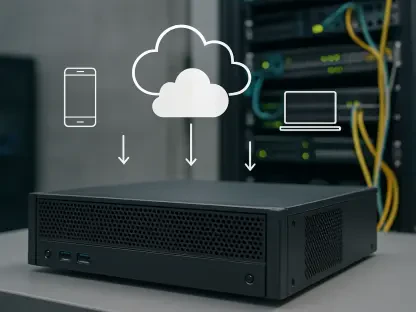Imagine a critical flaw in widely used virtualization software, actively exploited by a state-sponsored threat actor for over a year, yet the parent company remains silent about the ongoing attacks, leaving users vulnerable. This alarming scenario has unfolded with a high-severity zero-day vulnerability in VMware products, tracked as CVE-2025-41244. Discovered in early 2025, this flaw has sparked intense discussion within the cybersecurity community about transparency, state-sponsored cyber threats, and the security of virtual environments. This roundup gathers diverse perspectives from industry experts, researchers, and security analysts to explore the implications of the vulnerability, the exploitation by a Chinese state-sponsored group, and the muted response from Broadcom, aiming to provide a comprehensive view of this pressing issue.
Unpacking the VMware Vulnerability: Perspectives on a Critical Flaw
The Nature of CVE-2025-41244: A Technical Breakdown
Insights from various security research groups highlight the severity of CVE-2025-41244, a flaw affecting VMware Aria Operations and VMware Tools. Analysts describe it as a privilege escalation vulnerability that allows attackers to gain root-level access on virtual machines due to flawed logic in discovery functions. The simplicity of exploiting this issue, often through writable directories like /tmp/httpd, has raised eyebrows among professionals who note that such basic errors should not persist in enterprise-grade software.
Another angle comes from technical experts who point out the use of overly broad regular expressions in the software’s code as a root cause. They argue that this design oversight enables attackers to place malicious binaries in accessible locations, which are then executed with elevated privileges. This consensus suggests a need for stricter coding standards and more rigorous testing in virtualization tools that underpin countless business operations.
A third viewpoint emphasizes the timing of the discovery in 2025, underscoring how long this flaw may have been exploited undetected. Some researchers express concern that the ease of exploitation could mean other actors, beyond the identified threat group, have also leveraged this vulnerability. This perspective fuels urgency in addressing not just the flaw itself but also the broader practices around software auditing.
Scope and Impact Across VMware Products
Security firms have noted the extensive reach of this vulnerability, affecting both credential-based and credential-less modes in VMware Aria Operations, as well as the open-source open-vm-tools integrated into major Linux distributions. This wide impact has led to discussions about the cascading risks in interconnected systems, with many experts warning that a single flaw can compromise entire virtual infrastructures.
Another set of opinions focuses on specific products like VMware Cloud Foundation and Telco Cloud Platform, which are critical to many industries. Analysts in this camp stress that the scale of exposure is staggering, as these platforms support essential services globally. They advocate for immediate patch deployment as a non-negotiable step for organizations relying on these solutions.
A contrasting view comes from open-source advocates who highlight the challenges of securing components like open-vm-tools. They argue that the distributed nature of open-source software complicates timely fixes, as updates depend on coordination across multiple vendors and communities. This perspective calls for stronger collaboration to ensure vulnerabilities don’t linger in widely adopted tools.
Exploitation by UNC5174: Diverse Views on State-Sponsored Threats
The Role of a Chinese State-Sponsored Actor
Cybersecurity professionals tracking threat actors have identified UNC5174, a Chinese state-sponsored group, as a key player in exploiting this VMware flaw since at least early 2025. Many in the field describe this group as highly sophisticated, with a history of targeting critical infrastructure and technology firms, raising alarms about the strategic intent behind their actions.
A differing opinion suggests that the exploitation might not be entirely deliberate. Some researchers propose that the simplicity of the flaw could mean UNC5174 stumbled upon it opportunistically rather than through targeted research. This viewpoint sparks debate about whether the threat is limited to advanced actors or if less skilled groups could also exploit similar weaknesses.
Another angle focuses on the global implications of such state-sponsored activities. Experts in international cyber policy warn that these incidents reflect a growing trend of nation-state actors weaponizing software flaws for espionage or disruption. They urge governments and organizations to prioritize cyber defense strategies that account for such persistent and well-resourced threats.
Broader Cybersecurity Trends and Challenges
Analysts observing cybersecurity trends note that the VMware incident is part of a larger pattern where minor coding errors become significant attack vectors. They point out that as software complexity increases, so does the potential for overlooked flaws, a concern amplified by the rapid adoption of virtualization in critical sectors.
A separate perspective comes from threat intelligence specialists who caution that even basic malware could exploit flaws like CVE-2025-41244 for unintended privilege escalation. This insight challenges the notion that only advanced actors pose risks, suggesting that the cybersecurity community must prepare for a wider range of potential attackers.
Finally, some experts emphasize the evolving sophistication of state-sponsored groups like UNC5174. They argue that these actors are increasingly adept at blending malicious activities with legitimate system processes, making detection harder. This observation calls for advanced monitoring tools and a shift toward proactive rather than reactive security measures.
Broadcom’s Disclosure Approach: Transparency Debates
Reactions to Broadcom’s Silence on Exploitation
The cybersecurity community has expressed varied reactions to Broadcom’s decision to exclude mention of active exploitation in their advisories for CVE-2025-41244. Many professionals criticize this approach as a deviation from industry norms, arguing that transparency is critical for enabling organizations to prioritize responses and allocate resources effectively.
A contrasting view comes from some industry veterans who suggest that Broadcom’s silence might be a strategic choice to avoid panic or tipping off other attackers. While acknowledging the potential reasoning, they still stress that withholding such information can delay mitigation efforts, potentially leaving systems exposed longer than necessary.
Another opinion focuses on the impact on trust. Several analysts note that this lack of communication could erode confidence in Broadcom among customers and partners. They advocate for a balanced disclosure policy that informs without sensationalizing, ensuring stakeholders are equipped to act without being overwhelmed by fear.
Implications for Industry Practices
Experts in vulnerability management argue that Broadcom’s approach highlights a broader need for standardized disclosure practices across the software industry. They suggest that inconsistent communication can create confusion, especially when dealing with widely used platforms like VMware, and call for clear guidelines on when and how to report active exploitation.
A different perspective comes from legal and compliance specialists who point out that transparency is not just an ethical issue but also a regulatory one in many regions. They warn that failing to disclose active threats could expose companies to legal risks, particularly if breaches result from delayed responses by affected organizations.
Lastly, some thought leaders propose that this incident could serve as a catalyst for change in how vendors handle zero-day disclosures. They encourage the industry to adopt frameworks that prioritize rapid, clear communication while balancing the need to prevent further exploitation, fostering a culture of accountability in cybersecurity.
Key Takeaways from the Community Discussion
Practical Tips for Organizations
Security consultants offer actionable advice for organizations using VMware products, emphasizing the importance of monitoring for unusual child processes that could indicate exploitation. They recommend setting up alerts for anomalies in system behavior as a first line of defense against potential attacks stemming from this flaw.
Another tip shared by IT security teams focuses on analyzing legacy scripts, especially in environments using credential-based modes. They suggest auditing these scripts for vulnerabilities that could be exploited similarly to CVE-2025-41244, ensuring that outdated configurations don’t become entry points for attackers.
A final piece of guidance comes from patch management experts who stress the urgency of applying Broadcom’s updates immediately. They also advise maintaining a robust inventory of all VMware installations to ensure no system is overlooked, a step they deem critical given the widespread use of these tools.
Enhancing Security in Virtual Environments
Cybersecurity architects advocate for rigorous code audits as a long-term solution to prevent similar vulnerabilities. They argue that regular reviews of software logic and regular expressions can catch errors before they become exploitable, a practice that should be standard in virtualization software development.
A complementary view comes from threat detection specialists who recommend adopting proactive monitoring tools tailored for virtual environments. They highlight that real-time analysis of system activities can uncover exploitation attempts early, reducing the window of opportunity for attackers.
Another suggestion focuses on fostering collaboration between vendors and the open-source community. Experts in this area believe that joint efforts to secure components like open-vm-tools are essential, as shared responsibility can accelerate fixes and improve overall resilience against cyber threats.
Final Reflections on a Pivotal Cybersecurity Incident
Looking back on the discussions surrounding the VMware zero-day vulnerability and Broadcom’s response, the cybersecurity community reached a consensus on the need for heightened vigilance and transparency. The debates over state-sponsored exploitation by UNC5174 and the simplicity of CVE-2025-41244 revealed gaps in both technical defenses and communication practices. Moving forward, organizations should consider investing in advanced threat detection systems and advocate for clearer disclosure policies from vendors. Additionally, exploring resources on state-sponsored cyber threats and virtualization security can provide deeper insights for building robust defenses. This incident served as a critical reminder that collaboration between industry stakeholders remains a cornerstone of protecting virtual ecosystems against sophisticated adversaries.









